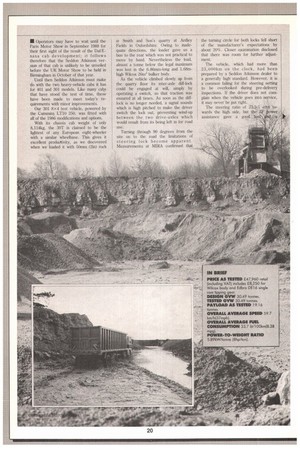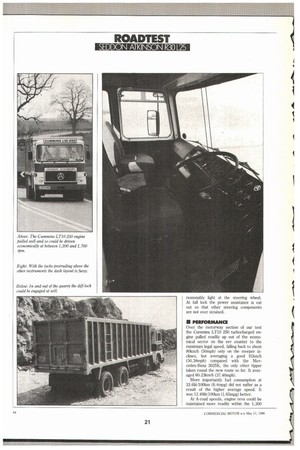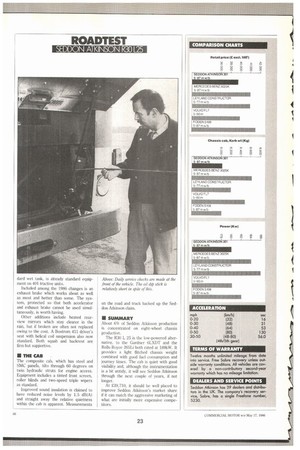• Operators may have to wait . until the Paris Motor
Page 128

Page 129

Page 130

Page 131

If you've noticed an error in this article please click here to report it so we can fix it.
Show in September 1988 for their first sight f the result of the Daf/Enasa cab development; it follows therefore that the Seddon Atkinson vet, .sion of that cab is unlikely to be unveiled before the UK Motor Show to be held in Birmingham in October of that year.
Until then Seddon Atkinson must make do with the two heavy-vehicle cabs it has for 401 and 301 models. Like many cabs that have stood the test of time, these have been made to meet today's requirements with minor improvements.
Our 301 884 test vehicle, powered by the Cummins LT10 250. was fitted with all of the 1986 modifications and options.
With its chassis cab weight of only 8,114kg, the 301 is claimed to be the lightest of any European eight-wheeler with a similar wheelbase. This gives it excellent productivity, as we discovered when we loaded it with 50rnin (21n) rock
al Smith and Son's quarry at Ardley f7ields in Oxfordshire. Owing to Madequ.ate directions, the loader gave us a bias to the rear which was not practical to move by hand. Nevertheless the load. almost a tonne below the legal maximum was lost in the 6.86mm-long and 1.68m high Wilcox 26m3 bulker body.
As the vehicle climbed slowly up from the quarry floor its inter-axle diff-lock could be engaged at will, simply by operating a switch, so that traction was ensured at aU times. As soon as the difflock is no longer needed, a signal sounds which is high pitched to make the driver switch the lock out, preventing wind-up between the two drive-axles which would result from its being left in for road use.
Turning through 90 degrees from the site on to the road the limitations of steering lock become apparent. Measurements at MIRA confirmed that the turning circle for both locks fell short of the manufacturer's expectations by about 20%. Closer examination disclosed that there was room for further adjustment.
The vehicle, which had more than 23,000km on the clock, had been prepared by a Seddon Atkinson dealer to a generally high standard. However, it is a common failing for the steering setting to he overlooked during pre-delivery inspections. If the dnver does not complain when the vehicle goes into service, it may never be put right.
The steering ratio of 23.5:1 errs 'towards the high side, but the Z}' wet• assistance gave a good "Ic.e
reasonably light at the steering wheel. At full lock the power assistance is cut out so that other steering components are not over strained.
• PERFORMANCE Over the motorway section of our test the Cummins LT10 250 turbocharged engine pulled readily up out of the economical sector on the rev counter to the maximum legal speed, falling back to about 801un/h (50mph) only on the steeper inclines, but averaging a good 811crn/h (50.38mph) compared with the Mercedes-Benz 3025K, the only other tipper taken round the new route so far. It averaged 60. 23krn/h (37.46mph).
More importantly fuel consumption at 33.6111/100km (8.4mpg) did not suffer as a result of the higher average speed. It was 12.491W100km (1.65mpg) better.
At A-road speeds, engine revs could be maintained more readily within the 1,300 to 1,700rpm sector. Here, too, the Seddon Atkinson 301 bettered the Mercedes on fuel consumption, returning 33.79ht/100km (8.6mpg), but with an average speed of 51.4km/h (31.9mph) which was slightly slower.
Over the whole 262.6km (163.7-mile) route the 301 returned a very healthy 33.75ht/100km (8,37mpg) at an average speed of 59.9krn/h (37mph) — very similar to the Mercedes, but with a difference of 8.731it/100km (1,72mpg). At this stage we should once again say that the 301 was running at about a tonne under the legal maximum of 30.48 tonnes.
To find out what would be the likely affect of adding the missing tonne we consulted the Cummins computer. While we could expect acceleration time to he longer — 4secs from 0 to 80km/h and 3secs for 50 to 80km/h times, overall fuel consumption is increased only slightly by 0. 591it/100km(0. 15mpg).
• DIUYOUNE Cummins' 10-litre engine is a very compact unit which does not need much room for installation. It has few hung-on components giving a very clean appearance. Its compact size is achieved with short connecting rods and a one-piece cylinder head. Both inlet and exhaust manifolds are on the same side and the rocker housing is incorporated in the inlet manifold.
The Eaton Fuller multi-mesh rangechange gearbox is very forgiving. Our only complaint is that gear changes are a bit slow between the lower ratios. The one hard climb on the route, a 16.5% (1 in 6) bank at Edge Hill, slowed the vehicle's progress so that we had to skip change down to first, but very quickly were able to change up a cog to reach the summit in 3min 41 secs.
Rapid and repetitive application of the ceramic faced clutch and an easy pedal action helped gear engagement. The thermostatically-controlled fan is relatively small, highlighting the thermal efficiency of the engine. indeed, Edge Hill was the only point where the engine worked hard enough for the thermostatically-controlled radiator fan to come into operation, Undoubtedly, the engine's efficiency benefits because most of the time power is not being consumed by the fan, but it is ironic, only when the engine is working at its hardest it is deprived of the 11kW needed to drive the fan.
• RIM AND HANDUNG Long front parabolic springs combined with the rear Norde rubber suspension to give an even ride with very little roll, on and off road.
Braking is also smooth, even full applications on the track failed to induce wheel locking. Seddon Atkinson's S cam brakes incorporate a camshaft set in needle roller hearings. An air dryer, replacing the stan dard wet tank, is already standard equipment on 401 tractive units.
Included among the 1986 changes is an exhaust brake which works about as well as most and better than some. The system, protected so that both accelerator and exhaust brake cannot be used simultaneously, is worth having.
Other additions include heated rearview mirrors which stay clearer in the rain, but if broken are often not replaced owing to the cost. A Bostrom 411 driver's seat with helical coil suspension also now standard. Both squab and backrest are firm but supportive.
• THE CAB The composite cab, which has steel and SMC panels, tilts through 60 degrees on twin hydraulic struts for engine access. Equipment includes a tinted front screen, roller blinds and two-speed triple wipers as standard.
Improved sound insulation is claimed to have reduced noise levels by 1.5 dB(A) and straight away the relative quietness within the cab is apparent. Measurements on the road and track backed up the Seddon Atkinson claim.
• SUMMARY About 6% of Seddon Atkinson production is concentrated on eight-wheel chassis production.
The R30 L 25 is the low-powered alternative, to the Gardner 61.XOT and the Rolls-Royce 265Li both rated at 189kW. It provides a light flitched chassis weight combined with good fuel consumption and journey times. The cab is quiet with good visibility and, although the instrumentation is a bit untidy, it will see Seddon Atkinson through the next couple of years, if not longer.
At 09,710, it should be well placed to improve Seddon Atkinson's market share if it can match the aggressive marketing of what are initially more expensive competitors.












































































































































